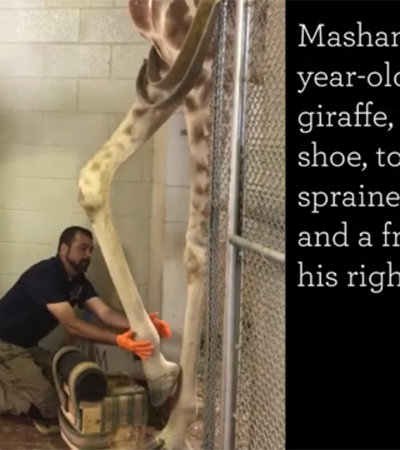Mashama, 9-year-old reticulated giraffe, is known for his outgoing personality and energetic presence in the Cheyenne Mountain Zoo giraffe herd. Lately, though, Mashama has been dealing with some foot and leg issues.
“We’ve discovered that Mashama has sprained ligaments and a fracture in his right foot,” said Dr. Liza Dadone, CMZoo head veterinarian and VP of mission and programs. “Combine those issues with a ligament strain in his right front wrist [that looks like the right front knee], which preceded the fracture, and we have a pretty complex case to solve.”
Mashama’s care team saw him limping after he stumbled during an especially playful day in the main yard a few months ago, and took x-rays of his foot. The x-rays revealed no significant damage, so his care team began to administer pain medications and moved him to a sand stall to let a perceived muscle strain heal with rest, over time. After a couple of weeks of normally effective sand stall rest for Mashama, the team noticed he wasn’t improving as much as they would have liked to see, so they performed additional testing.
Those tests revealed that he had developed a fracture in his right front foot. CMZoo’s veterinary team, keepers, trainers and animal care managers have been working together with outside partner organizations to consider every possible treatment for Mashama.
One of those treatments is a customized ”shoe” that adheres to his right front hoof. CMZoo regularly works with specialized farriers from the Zoo Hoofstock Trim Program (ZHTP), a subspecialty of the Equine Lameness Prevention Organization. The ZHTP team built Mashama a custom “shoe” in early April 2019 that seemed to help stabilize the foot fracture while it healed. Almost immediately, from the time the shoe was in place, Mashama appeared to be putting more weight on his right front foot, indicating he was much more comfortable. After several weeks of healing, he was able to access an outside side yard, which has smoother terrain than the main yard.
Earlier this month, Mashama’s shoe came unglued and had to be removed. The team built him a second shoe and applied it mid-May.
In the accompanying video from May 15, 2019, Mashama receives his new shoe. Steve Foxworth, CMZoo’s farrier expert, from ZHTP, explains the shoe’s design and material, and Mashama’s team displays his incredible participatory behaviors that allow them to care for him in situations like this.
“Two months into this path, he’s looking better and better,” said Dadone. “We are by no means out of the woods, but we’re seeing improvements and will continue exploring other options that will help Mashama address the issues in his wrist and foot. A fracture and a sprained ligament could go on to cause significant health problems for him, if we’re unable to stop their progression.”
Because Mashama is such an exemplary participant in his own health care, he is trained for blood draws. His comfort level with blood draws makes him an ideal candidate to receive IV injection treatments that could help him.
“One option we’re considering is an equine medication we’ve used in other giraffe that increases bone density,” said Dadone. “The drug is administered intravenously and must be absorbed in the affected areas for ten minutes. This drug could reverse the course of his injuries, but it’s not easy to administer.”
Staff would need to apply a tourniquet to Mashama’s leg and administer the drug through an IV into the lower portion of his right front leg – giving the most deteriorated bones the best opportunity to absorb the drug. The tourniquet would need to stay in place for ten minutes. That’s a long time to ask an energetic and curious animal like Mashama to stay still.
“Normally, we need to anesthetize an animal to administer this drug,” said Dadone. “But since Mashama is such a rockstar at training, we’re going to see if he’ll participate in training to stay still for that long. It’s always a last resort to anesthetize an adult giraffe, because there are more potential risks than with other animals, so keeping him awake for the procedure would be best.”
Another option is stem cell treatments to help reduce inflammation and speed healing in his foot bones and sprained wrist joint. CMZoo has successfully used this treatment with other giraffe in the herd, but again, the treatment process is complicated. Stem cells have to be administered through the jugular vein in the neck, and have to be kept at a very cold temperature, which would be an unusual sensation for Mashama.
“We’re not quite there yet, but it’s an option. It’s on the experimental side, but we have seen it help in a small number of cases at our Zoo and a few others,” said Dadone. “We’ve tried laser therapy, hoof trims and sand stall rest, to no avail for him. The shoes are offering some comfort and relief, but we’re looking at all options to help him recover long-term.”
Mashama’s team of CMZoo vets, keepers, trainers and staff will continue working to test solutions for him. For now, the new rubber shoes appear to be helping Mashama walk and stand more comfortably, and he’ll return to the outdoor yard with the rest of the herd when his care team decides it doesn’t pose a risk of further injury for him.
We’ll keep you updated on Mashama’s progress, and hope to see him soon return to his former playful self with the success of these potential treatments.

